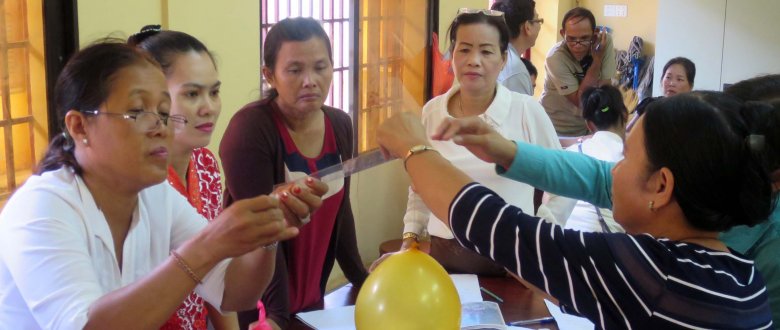
Although the number slowly decreases, the teacher-pupil ratio in Cambodia is still very high. One teacher to 45 pupils is even compared to neighbouring countries a high number. Knowing that this is just an average ratio, the reality is that classrooms with 50 or more pupils are quite common.
It is no surprise then that primary school teachers at the beginning of the MoEYS-VVOB science training had serious doubts about managing science experiments in their classrooms:
- “There is not enough room.”
- “The children will be out of control.”
- “It’s too difficult to assess if pupils learned something from an experiment.”
- “We will need a lot of material and a lot of time.”
- “Our schools do not have enough budget for this.”
- “We don’t have a lot of time.”
Science training for primary school teachers in 18 provinces
Science teacher trainers from every Teacher Training Centre facilitated nationwide science trainings to challenge these teachers’ beliefs. Successfully so!
2,092 primary school teachers and school principals joined these trainings on the topics of Chemistry and Physics in the second half of 2016.
The teachers’ issues were actively addressed in the training and they experienced that it is possible to do science experiments in their current class context. To support their teaching, the teachers received the developed manual that contains a variety of zero or low cost experiments. For example, with just a little salt, flour, water and a water bottle, you can do an experiment on the mixture of materials. The teachers further experienced that by doing these experiments with the pupils, the pupils gained skills and deeper understanding about science. More so, the experiments actually linked to their daily lives.
Trying-out is knowing
So, how do you approach a big group of pupils to organise station/corner work? First of all, it’s important that each group of pupils has a clear division of tasks. Each group member is assigned a role as time keeper or note taker. This ensures that all pupils are engaged and not just the quick ones.
Close monitoring by the teacher is necessary. Finally, a good wrap-up with the whole class at the end of the lesson is crucial.
During the training the teachers went through the whole process of a lesson with the use of experiments. They practised every step. The teachers prepared the lesson and tried it out with pupils. The pupils worked in groups while the teachers practised using the Inquiry Based Learning concept.
In Inquiry Based Learning the pupils receive a clear key question and reflect on that question through a step-by-step experiment. In small groups the pupils look at their experiment results. The teacher then brings the whole class together and concludes on the key question.
After the training the teachers went back to their schools with a manual filled with usable experiments and even more importantly, changed perceptions. They personally experienced that it is possible to organise low cost science experiments in their large classes and reach good learning outcomes. They are enthusiastic to integrate the experiments in their own classrooms.







